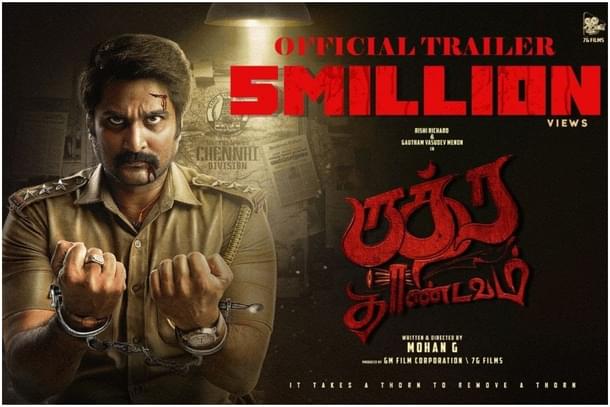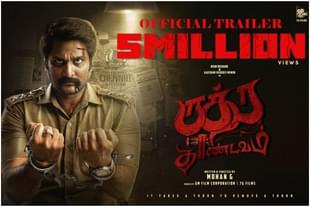Ideas
'Rudra Thandavam': Review Of A Review
Aravindan Neelakandan
Oct 04, 2021, 11:48 AM | Updated 11:48 AM IST
Save & read from anywhere!
Bookmark stories for easy access on any device or the Swarajya app.


The release of Rudra Thandavam (2021), the much talked about movie by G. Mohan, has generated shock waves.
The power structure of the Tamil Nadu movie industry has strict taboos and fatwas. If you have to be a 'progressive', you have to show one community as perpetual aggressors and associate them with Hindu symbols and another community as complete victims with Buddhist symbolisms.
Such movies, which play on colonial-sociological stereotypes, have been profitable and prestigious. On the other hand, in Rudra Thandavam, the director uses the sacred tradition of his own community Sri Vanniyar Puranam, which speaks of Vatapi, an Asura who was killed by Vanniyar warriors who were the children of Shiva.
By naming the hero Rudra Prabhakaran confront a villain named Vatapi Rajan, the movie takes a plunge into the collective psyche of a major Tamil population.
Given the fact that movies like Karnan had played on similar names with intentional inverting of the roles, this movie in fact tries to stand on the strength of the traditional archetypes than positing false stereotypes on them.
The establishment media reviews of the movie have been negative. One such review is the one that appeared in The Hindu. It is explicitly titled ‘‘Rudra Thandavam’ movie review: A dangerous piece of work to ‘erase’ caste from caste-based violence.’
This article not the review of the movie but a review of the movie review.
The Hindu review speaks about the George Floyd killing in the US and rhetorically asks if there were to be a movie justifying the killing? It then goes on to say that in the Indian context, it would be this one.
How justified is such a statement?
Let us be honest. There have been movies in the mainstream which have time and again justified the high-handedness of the police. For example, the movie Saamy (2003) directed by popular director Hari had a scene that had alluded to the infamous 'Tamirabarani' massacre of 1999 in which mostly estate workers who went on a rally demanding raise in their wages in 1999 were killed.
In Tamil Nadu, there are indeed many custodial deaths. However, such deaths are more due to police high-handedness and inhumanity than any religion-caste nexus, as the reviewer alleges.
At the same time, it is a well-known fact that quite a number of human rights groups — not all — function like mafias, helping the perpetrators and demonisng the victims.
Caste and religion play a major role here. It is also a well-known fact that outfits like Popular Front of India (PFI) are part of a well-oiled ecosystem which lobbies against India in international fora.
A proper criticism of the human rights mafia in the media has been long overdue. If this movie has done that and has made the Tamil people aware of the abuse of 'protection' of human rights then it is actually a welcome step in the right direction.
In a video clip that went viral, a Viduthalai Chiruthaikal Katchi (VCK) leader openly threatened IPS officers that theirs was a party that grew up on the slogan of retaliation.
The VCK party, which is part of the ruling coalition in Tamil Nadu, has alleged that the police crackdown against anti-social elements is actually a drive targeting their party cadre. The same party’s leader also stated that the women of a particular community are attracted to the youths of his own caste because the men of the other community lacked ‘stuff and style’ — an innuendo better left unexplained.
The young director, Mohan, had been responding to such social realities through his art medium boldly.
The reviewer in The Hindu writes that the director ‘has introduced a dangerous concept called: crypto-Christians’ and accuses the director of lacking knowledge of history.
But it is the reviewer who stands exposed. The movie Thuppaki (2012, directed by Murugadhas) made the term ‘sleeper cells’ quite popular among its audience and this movie has made the public aware of the term ‘crypto-Christian.’
The term ‘crypto-Christian’ was not coined by Hindutvaites. It was coined by David Barrett, an evangelical strategist in 1982 in his World Christian Encyclopaedia and the term was changed to ‘hidden Christians’ in its 2001 edition.
Gandhian and Hindu thinker Ram Swarup, in his review of the Encyclopaedia in The Organiser, brought the term to the notice of Indians.
In Tamil Nadu itself, an IAS officer from an SC community does rabid fundamentalist evangelism in which he goes to the extent of asking his followers to beat those Christians who seem to indulge in idol-worship and his posters call for the death sentence upon homosexuals.
There are many such officials who get into the power structure using their caste certificate, but use their position for their evangelist agenda. So, 'crypto-Christian' is indeed a dangerous phenomenon in reality, threatening the fabric of communal harmony.
In fact, far from stereotyping any caste or religion, the movie asks for a humanistic caution. Given the possibility of the sensitivity of the issue — which may polarise communities — the director has made a Christian and a Scheduled Community lawyer as the ones bravely fighting against the corrupting forces in society.
The same cannot be said of certain other movies that received glowing reviews in the progressive circles of the establishment media.
So, the progressive-pretends sitting in the ivory towers should get out of their career and class comfort zones before they demean the efforts of a brave young director such as G. Mohan, who dares to speak truth to power.
Aravindan is a contributing editor at Swarajya.




